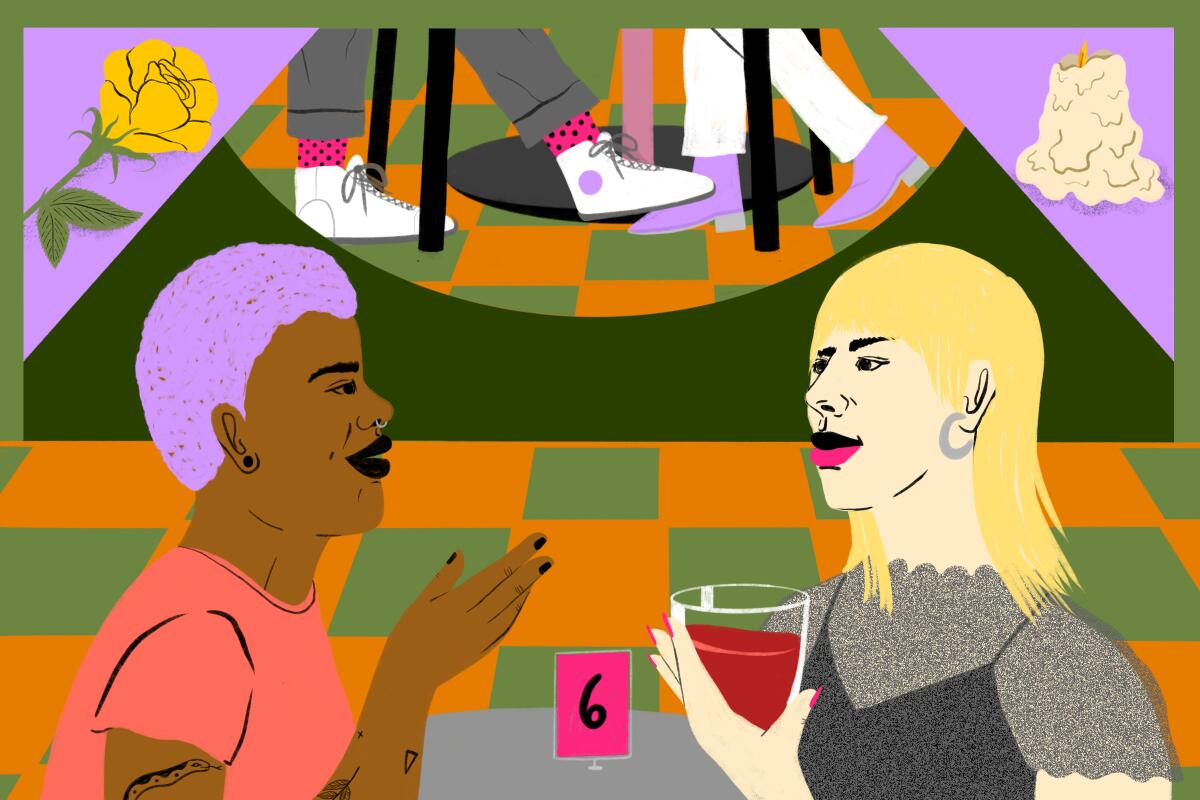Striking Hollywood workers are feeling the strain when rent is due

- Share via
Good morning. It’s Friday, Sept. 22. Here’s what you need to know to start your day.
- Some Hollywood workers are struggling to keep up with housing costs.
- Echo Park Lake has a goose problem.
- Eat your way through the most delicious weekend in L.A.
- And here’s today’s e-newspaper
Sign up for Essential California
The most important California stories and recommendations in your inbox every morning.
You may occasionally receive promotional content from the Los Angeles Times.
Striking Hollywood workers are feeling the strain when rent is due
For Hollywood’s striking workers, it’s been quite a few months of waiting and their pockets are stretched thin.
Back in July, Deadline reported that one studio executive said the “endgame is to allow things to draw on until union members start losing their apartments and losing their houses.”
In a city with notoriously high housing costs, eviction is a real threat. It remains unclear whether the length of the strikes have contributed to a rise in evictions.
Still, entertainment industry workers told me they’re struggling more than ever to afford housing. And for some, time may be running out — despite positive signs of progress in negotiations this week between the Writers Guild of America and the Alliance of Motion Picture and Television Producers.
Some workers struggle to pay for rent and other living expenses
Buffy Charlet moved to Los Angeles from Reno in 2004 and has worked as an actor and as a casting associate for the last 19 years. During the height of the COVID-19 pandemic, she and her husband, both members of the Screen Actors Guild-American Federation of Television and Radio Artists, worked as COVID-compliance officers.
She is one of the thousands of workers who have been affected by the strike since July, when SAG-AFTRA authorized a walkout. Two months later, money is getting tight and she’s still looking for work.
Although her family lives in a rent-controlled apartment in Miracle Mile, Charlet is struggling to pay her $2,700 rent, especially with other expenses that include $1,270 a month for child care for her 4-year-old son. Her neighbor’s unit is twice the price of hers and she’s afraid that her landlord will eventually increase prices.
“It would be absolutely devastating to us because we’re barely hanging on right now,” Charlet told me. She’s had to go through her savings and cash out part of her 401(k).
“We are literally selling things that we have right now. Like, ‘can we get 100 bucks for this? $50 from this? It’s just a daily grind and a struggle,’” she said.
Avenues for help are overwhelmed
Organizations that distribute aid to Hollywood workers have distributed thousands of grants, but officials say demand is only growing higher and more widespread.
Keith McNutt, a former social worker and the director of the western region of the Entertainment Community Fund, has overseen aid distribution to performing arts and entertainment workers throughout different forms of crises. He said that social workers at the fund have seen more people with three-day eviction notices asking for help. Rent is often the first fire to put out.
“In normal times and in crisis times, the number one thing that people come in asking for help with is rent,” he said. “No matter how you’re doing, no matter what your station in life is, your biggest monthly expense is going to be your rent or your mortgage. That certainly carries through to the strike.”
As of this week, the Entertainment Community Fund (formerly known as the Actor’s Fund) has distributed more than $7.1 million to more than 3,400 film and TV workers. The SAG-AFTRA Foundation’s Emergency Financial Assistance and Disaster Relief Fund has distributed more than 2,100 grants to its union members. Grants for both organizations can range between $1,000 to $3,000.
The nature of the entertainment industry is gig work and in order to receive aid, workers must meet certain conditions and work-history requirements.
That means some of the workers most affected by a lack of work are the lowest paid — such as those starting out or those with inconsistent work due to disabilities or other life circumstances.
But even those who do qualify have limited options. With the overwhelming need, each individual can receive only one grant.
Charlet and her husband together received $3,500 in grants from the SAG-AFTRA Foundation fund, which helped cover rent and child care for September. But given an uncertain end to the strike, she is not sure what to do for October.
Relief could come through a bill passed in the California Legislature last week, which would allow striking workers to apply for unemployment benefits. But Gov. Gavin Newsom still needs to sign off on it.
For now, workers must wait and Charlet is willing to hold out. When I asked her whether the financial strain is putting any pressure on negotiations, she said “absolutely.” But she’s been feeling a decline in wages for years now.
“It’s been hard to survive even before this and it’s getting harder to make a middle-class living in this industry,” Charlet said. “The only way that we’re going to have a full and vibrant and exciting entertainment industry, and one that is in any way equitable — we just have to keep going forward.”
Today’s top stories

Climate and environment coverage
- The Echo Park Lake homeless encampment is gone. So is the fence. The problem now? Geese.
- The late-summer itch: Ankle-biting mosquitoes are in extra full force in L.A. Why?
- Gov. Gavin Newsom headed to New York this week to talk up his administration’s efforts to combat climate change, and to take a swing or two at Republicans.
- Insurers agreed to return to the high-risk fire zones in the hills and canyons of California in exchange for concessions that will make it easier for them to get rate increases approved.
- Will President Biden’s new American Climate Corps match the success of the California Conservation Corps?
Must-read education stories
- New policies requiring schools to notify parents if a student is gender-nonconforming are seeping into campus culture in ways some students find dangerous.
- Do you call it Cal or Berkeley? The UC school may rebrand to Cal Berkeley for sports.
Healthcare in California
- Some San Francisco Bay Area healthcare workers will have to mask again as the threat of COVID and the flu looms.
- California is suing clinics over ‘abortion pill reversal’ claims.
More big stories
- A California law that bars people under restraining orders from possessing firearms survived a federal court challenge Thursday.
- Rupert Murdoch, the powerful and polarizing media mogul, steps down as chairman of Fox.
- A study published in Science estimated that Mexican cartels recruit about 360 workers each week to replace those lost to violence or incarceration.
- Black immigrants face more discrimination in the U.S. The source is sometimes surprising.
- By the time he sidled up to a patrol car and shot two Los Angeles County Sheriff’s deputies at point-blank range, Deonte Lee Murray was in the midst of a crime rampage.
- Dodgers’ foul ball nearly kills a goose. Is the sighting an omen of another playoff disaster?
- LaVar Ball knows exactly what young athletes need: A set of $1,850 exercise bars.
- Tracking home and rent prices in Southern California.
- What’s the current status of DACA? Here’s what you need to know.
Get unlimited access to the Los Angeles Times. Subscribe here.
Commentary and opinions
- Op-ed: Scientists need U.S. leaders to step up and defend them.
- Op-ed: California needs new rules as it forces more mentally ill people into treatment.
- Lorraine Ali: Outrage fueled the ascension of Rupert Murdoch’s TV empire — a boon for entertainment but not news.
Today’s great reads
Long live Lisa Frank! Gen Z, 40-year-olds and even babies are channeling a ‘90s revival. The ‘90s are back, and brands that millennials loved as children or young adults — Lisa Frank, My Little Pony, Paul Frank with the wide-mouthed monkey face and more — are now banking on their old customers wanting to relive their childhoods through their children.
Other great reads
- L.A. County leaders promised to direct some of the billions in procurement dollars they spend every year to boost small, local businesses. Then came the scams.
- Why would Disney want to sell ABC?
- This L.A. Italian restaurant chain was an incubator for star chefs. Now, one location remains.
- This museum wants to ensure that future generations can see Compton’s historic art contributions.
How can we make this newsletter more useful? Send comments to essentialcalifornia@latimes.com.
For your downtime
Going out
- 💏 L.A. is the best place to speed date. Here’s how to get in on the fun.
- 🍜 The most delicious weekend in L.A. starts tonight at the L.A. Times Food Bowl’s Night Market.
- 🍽️ It’s banchan heaven at Perilla, L.A.’s vital new lunchtime destination.
- 🎥 ‘Satanic Hispanics’ is bringing Latino horror to the big screen.
Staying in
- 📕 In the new book, “American Gun: The True Story of the AR-15,” two journalists write about how the AR-15 became America’s most popular and deadly weapon.
- 🍲 Here’s a recipe for abundant chicken potpie.
- ✏️ Get our free daily crossword puzzle, sudoku, word search and arcade games.
And finally ... a great photo

Today’s great photo is from photographer Juli Perez. The Mexican and Central American communities of Los Angeles celebrated the independence days of their countries across the city last weekend with events brimming with food, music and plenty of pride.
Have a great day, from the Essential California team
Helen Li, reporting fellow
Elvia Limón, multiplatform editor
Kevinisha Walker, multiplatform editor
Laura Blasey, assistant editor
Check our top stories, topics and the latest articles on latimes.com.
Sign up for Essential California
The most important California stories and recommendations in your inbox every morning.
You may occasionally receive promotional content from the Los Angeles Times.









